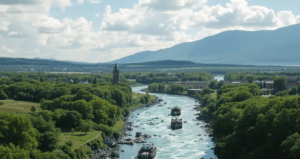Socio-Hydrology Breakthrough: 5 Powerful Strategies for Climate-Resilient Water Governance in South Asia
Socio-hydrology explores the intricate relationship between human societies and water systems, offering valuable insights for climate-resilient governance. As climate change intensifies, understanding how human actions shape hydrological processes is crucial for sustainable water management. This paper examines recent socio-hydrology advancements and their role in shaping policies that promote resilience. In South Asia, where water resources cross national borders, socio-hydrology provides a framework for fostering cooperation and equitable water distribution.
By integrating social, economic, and political factors, it helps develop inclusive policies and conflict-resolution strategies. The study also evaluates modeling approaches like Integrated Assessment Models (IAMs) and Agent-Based Models (ABMs) that aid in adaptive water governance. Addressing transboundary disputes and protecting vulnerable communities requires collaborative and flexible governance. Further research is essential to maximize socio-hydrology’s potential in tackling climate and water challenges in the region.

Socio-Hydrology Breakthrough: 5 Powerful Strategies for Climate-Resilient Water Governance in South Asia
Climate change is reshaping water availability and access worldwide, and South Asia—home to over a billion people—is particularly vulnerable. The region’s rivers, glaciers, and groundwater systems are under stress due to rising temperatures, erratic monsoons, and growing demands from agriculture, industry, and cities. To tackle these challenges, experts are turning to socio-hydrology, a field that combines water science with insights into human behavior, economics, and governance. This approach helps us understand how people and water systems interact, and how these interactions shape resilience to climate shocks.
What is Socio-Hydrology?
Socio-hydrology bridges the gap between physical water systems and the societies that depend on them. Traditional hydrology focuses on water cycles, rainfall patterns, and river flows. But socio-hydrology goes further by asking: How do human choices—like farming practices, urban planning, or water-sharing policies—affect water availability? Conversely, how do droughts, floods, or shrinking glaciers influence social and economic outcomes? By studying this two-way relationship, policymakers can design solutions that are both ecologically sustainable and socially equitable.
For example, in South Asia, farmers relying on monsoon rains might over-pump groundwater during dry spells, depleting aquifers. Socio-hydrology examines why communities make these choices (e.g., lack of alternative livelihoods, poor water pricing) and how policies could incentivize better practices.
Why South Asia Needs This Approach
South Asia’s water crisis is deeply tied to its geography and politics. Major rivers like the Ganges, Brahmaputra, and Indus flow across borders, creating tensions between neighboring countries. Upstream dams or pollution in one nation can devastate downstream communities in another. Meanwhile, unequal access to water often leaves marginalized groups—small farmers, women, or low-income households—bearing the brunt of shortages.
Socio-hydrology offers tools to address these complexities. By mapping how power dynamics, economic pressures, and cultural norms shape water use, it promotes cooperation over conflict. For instance, India and Bangladesh have historically clashed over the Teesta River’s waters. A socio-hydrological lens could help both nations craft agreements that balance agricultural needs, ecological health, and shared risks from climate change.
Building Resilience Through Inclusive Policies
Climate resilience isn’t just about building dams or installing irrigation systems. It requires governance systems that listen to diverse voices, especially those often excluded. Marginalized communities—such as Nepal’s mountain villages or Bangladesh’s coastal populations—face unique vulnerabilities. They might lack the resources to adapt to floods or droughts, yet their traditional knowledge (e.g., rainwater harvesting techniques) could offer valuable solutions.
Socio-hydrology pushes policymakers to ask:
- How do existing laws or institutions ignore local needs?
- Can water-sharing agreements be redesigned to prioritize equity?
- How can climate forecasts be communicated effectively to remote villages?
Case studies show progress. In India’s Maharashtra, participatory groundwater management programs have empowered villages to monitor aquifers and set usage rules. In Nepal, community-led flood warning systems have reduced disaster risks. These examples highlight the importance of blending science with grassroots participation.
Tools for Smarter Decision-Making
To navigate climate uncertainty, researchers use models that simulate human-water interactions:
- Integrated Assessment Models (IAMs): These evaluate how policies (e.g., carbon pricing, irrigation subsidies) affect water, food, and energy systems over time.
- System Dynamics Models: They map feedback loops—like how water scarcity drives migration, which then alters water demand in cities.
- Agent-Based Models (ABMs): These simulate individual actions (e.g., a farmer switching crops) to predict broader impacts on water resources.
- Scenario Planning: This explores “what-if” futures, such as prolonged droughts or sudden glacial melts, to prepare flexible strategies.
Such tools help governments test policies before implementing them. For example, how might a new dam affect downstream ecosystems and livelihoods? Could crop diversification reduce groundwater stress?
The Road Ahead
South Asia’s water future hinges on collaboration. Transboundary rivers demand joint management frameworks that prioritize sustainability over short-term gains. Climate adaptation plans must address inequalities—ensuring women, indigenous groups, and the poor have a seat at the table.
Investing in socio-hydrological research is critical. We need better data on glacier melt rates, groundwater depletion, and shifting rainfall patterns—but also on how policies affect human behavior. Universities, governments, and NGOs must work together to train water managers in interdisciplinary thinking.
Ultimately, socio-hydrology reminds us that water crises are not just technical problems. They reflect deeper issues of governance, justice, and human adaptation. By uniting science with social insight, South Asia can pioneer climate-resilient water systems that protect both people and the planet.
You must be logged in to post a comment.